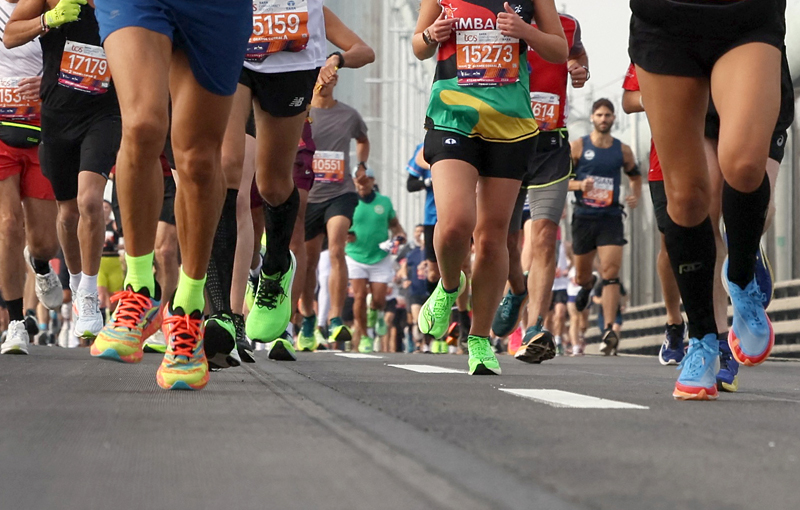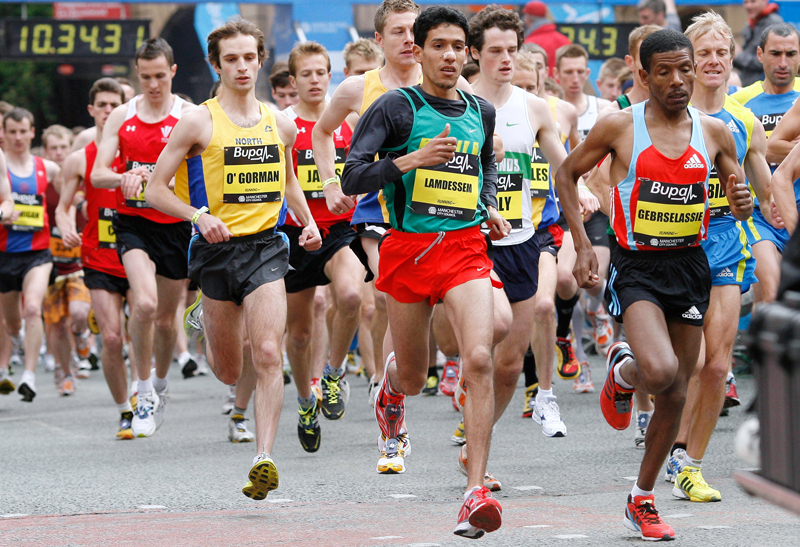Strength training: does slow training increase muscle mass?
Do super-slow workouts build super-strong muscles?
Recently some commentators in the US popular press have been raving about something called ‘super-slow’ resistance training, a form of strength training in which all movements are carried out in a very slow, careful and deliberate manner. Although the ‘buzz’ about super-slow exercise is fairly new, the technique was originally introduced as far back as 1982 at the University of Florida by a researcher named Ken Hutchins, who used the method in an osteoporosis study carried out with older women.Athletes who engage in super-slow strength training in effect carry out their workouts in slow motion, with a heavy emphasis on coordination, form and control rather than speed. Proponents contend that this technique has a greater impact on strength and muscle size than traditional weight training, as well as promoting the more effective loss of body fat. (For details, see Hutchins’ book, Super Slow, or visit his web site – www.superslow.com). In addition, super-slow training is said to provide a higher-quality aerobic workout than conventional weight work. As one might expect, videos and even special training equipment have been marketed successfully to the general public. However, the scientific research on super-slow training has been rather scant.
In fact, some exercise physiologists have been quite sceptical about the merits of super-slow training. As some of these heretics point out, the energy cost associated with a specific strength workout is influenced primarily by the amount of work performed during the session and the relative intensity (the percent of the one-repetition max) at which it is performed. Resting energy expenditure can increase after a strength workout, but the magnitude of this increase also seems to depend on the volume and intensity of the strength work carried out during the session. In a super-slow workout, both volume and intensity of work are likely to be fairly low. (Think, for example, about the maximum amount of weight you can bench-press – and then think about trying to hold and lift this weight for a full 10 seconds; you will immediately realise why super-slow training must be linked with modest intensities, ie resistances well below the one-rep max.) Thus, it is somewhat hard to see how super-slow training would spur metabolism in an exceptional way and lead to greater-than-usual fat loss.
Study fills the information gap
Until recently, these arguments have been essentially theoretical in nature, with very little research evidence either way. Now, however, scientists from the University of Alabama have stepped in to fill the information gap with a study comparing the metabolic effects of super-slow and traditional strength training in seven young men who had been engaged in strength training for at least one year. All of the subjects had stable body weights, averaging 79kg, and routinely carried out weight training with a combination of free weights and exercise machines. Their usual training involved 2-3 sets of various exercises, with 8-10 repetitions and an intensity of 65-70% of the one-repetition maximum (1RM) for each exercise. The athletes’ average 1RM for the bench press was 117kg, and it was 144kg for the squat.
In this study, each athlete completed two workouts designed to train all of their major muscle groups, one using a traditional-training technique and the other the super-slow method. The workouts were separated by a three-day interval and the subjects were randomly assigned to a treatment order – either super-slow training first or traditional training first. The actual exercises performed included leg extensions, bench presses, biceps curls, leg curls, French curls, bent rows, reverse curls, military presses, upright rows and squats. Heart rates and minute-by-minute oxygen-consumption rates were recorded during each workout and for 15 minutes after the sessions as well; blood-lactate levels were measured immediately after the training ended. On the morning after each workout (following a 12-hour overnight fast), the rate of resting energy expenditure was measured in each athlete.
The super-slow session involved one set of eight repetitions of each exercise, with 10 seconds of concentric and five seconds of eccentric action for each rep. In accordance with Hutchins’ recommendations, one minute of rest was permitted between exercises.
Exercise time versus workout duration
In their pilot work that preceded the study, the Alabama researchers quickly learned about an important – and potentially very limiting - aspect of super-slow training. When they attempted to determine how much resistance could be used during the performance of eight super-slow repetitions of the exercises, they found that none of the subjects could complete the required eight repetitions for any exercise with more than 30% of 1RM as the resistance! In fact, the average maximal percentage of 1RM with which the athletes could complete eight super-slow reps was 28%! Since all of the seven athletes could handle 25% of 1RM, this intensity was chosen for the super-slow workouts. As an astute reader, you can immediately see how super-slow training had a remarkably limiting impact on the intensity of effort used during the workout: 25% of 1RM is considered a very light resistance, and the average intensity used by most athletes during strength workouts is about 70% of 1RM.
The Alabama researchers wanted to make sure that the traditional workout took the same amount of time as the super-slow session. Obviously, given this constraint, the number of reps could not be equivalent, since each traditional rep could be completed more quickly than a super-slow repetition. No instructions were given on how long each traditional rep should take; the subjects were simply instructed to exercise in a natural way. As it turned out, however, the athletes usually required one second to complete the concentric phase of each traditional rep and one second to finish the eccentric portion. Thus, when the subjects completed two sets of eight repetitions of every exercise in the traditional workout, with a one-minute rest after each exercise, the total workout took 29 minutes – the same amount of time needed for the super-slow session. The intensity chosen for the traditional workout was a very typical 65% of 1RM.
As you have probably already realized, the actual amount of time spent exercising differed between the two workouts, even though workout duration was the same. While performing the super-slow session, the athletes spent 10 x 8 x 15 seconds = 1200 seconds (20 minutes) actually doing work. By contrast, they worked for just 2 x 10 x 8 x 2 seconds = 320 seconds (5:20) during the traditional session, albeit at a higher intensity.
Although less total time was spent actually exercising during the traditional workout, oxygen-consumption and heart rates were much higher during and after the workout than for its super-slow variant. For example, average heart rate during the traditional workout was 143 beats per minute, compared with just 113 beats per minute during super-slow activity; average recovery heart rate with traditional training (recorded during the 15 minutes after the workout ended) was 119 beats per minute, compared with just 95 beats per minute with super-slow. In effect, the recovery heart rate associated with traditional training was greater than the working rate during super-slow exercise!
Data on net energy expenditure also failed to reveal any advantages for super-slow training. For example, during the workout and 15-minute recovery period, traditional athletes expended a total of 172 calories compared with a paltry 107 kcals for the super-slow folks. Even post-exercise lactate levels favored traditional training, with lactate soaring to 7.9 millimoles per litre after traditional training, compared with just 4.0 after super-slow training. It is important to note that this lactate elevation would not increase the risk of muscle soreness in the traditional trainers since, contrary to popular belief, lactate is not linked with post-exercise muscular distress. Elevated concentrations of lactate during workouts are actually considered to be good for athletes, since they stimulate muscle cells to get better at ‘picking’ lactate out of the blood, then using it as an important energy source during exercise.
‘Morning-after’ measurements of energy expenditure revealed that super-slow athletes did not enjoy higher metabolic rates than traditional trainers. Thus, contrary to the claims made by advocates of super-slow training, there were actual metabolic disadvantages associated with super-slow efforts. As the Alabama researchers pointed out, the amount of energy expended by the super-slow athletes during their 29-minute workouts was actually less than one would expect to burn during leisurely 20-minute-per-mile walking over the same time period, while oxygen consumption was too low to hike aerobic fitness.
To put it simply, the actual intensity of super-slow training (25-28% of 1RM) is so meagre that it is very difficult for this form of exercise to hoist metabolism in any significant way. By contrast, the usual intensity of traditional strength training (65-75% of 1RM) is considerably higher, with greater consequent metabolic benefits. In addition, the greater resistances used for traditional training allow for the completion of more total muscular work than during super-slow sessions, even though the latter involve longer contraction times and more time spent lifting and lowering weight. In the Alabama study, four times as much muscular work was performed during the traditional session than during the super-slow workout, even though the muscle-contraction time advantage favored super-slow effort by almost 4-1 (1200 seconds vs 320 seconds).
How about strength, though? Does super-slow work, in which the duration of individual contractions is dramatically increased, confer special strength benefits? In a recent investigation, the gains in strength associated with 10 weeks of traditional resistance training were compared with those resulting from 10 weeks of super-slow training (5). The subjects were 14 women, aged 19-45 years, who were randomly assigned to either regular or super-slow groups. Both groups trained three times a week during the study period, performing leg presses, leg curls, leg extensions, anterior lateral pull-downs, bench presses, seated rows, biceps curls, and triceps extensions.
No evidence of metabolic boosting
As expected, the super-slow group used a 10-second-concentric and five-second-eccentric contraction sequence; the traditional exercisers employed two seconds of concentric and four seconds of eccentric action for each rep. Both groups completed one set of 8-12 reps to muscular fatigue for each exercise. The traditional athletes used an intensity of 80% of 1RM, while the super-slow athletes settled for 50%. Both groups took a 60-90-second rest between exercises and, as they grew stronger over the course of the study, resistance was increased in 2.5-5-% increments.
After 10 weeks, the traditional group had improved 1RM significantly more than the super-slow group for the bench press (34% vs 11%), the anterior lat pull-down (27% vs 12%), the leg press (33% vs 7%), leg extensions (56% vs 24%) and leg curls (40% vs 15%). The traditional group’s improvement in total weight lifted was significantly greater than that of the super-slow group (39% vs 15%). Both groups improved endurance, as measured on a cycle ergometer, to the same extent, and neither achieved a significant improvement in body composition. Thus, in this study super-slow training offered no advantages at all over conventional resistance work.
A separate study carried out by super-slow advocate Wayne Westcott and colleagues, however, provided evidence to support the use of super-slow workouts. In this investigation, carried out in Quincy, Massachusetts, 82 previously untrained men and women carried out regular-speed strength training 2-3 times a week for 8-10 weeks, while 65 others undertook super-slow training with the same frequency over the same period. Both groups performed a 13-exercise Nautilus circuit, completing one set of each exercise per workout. The regular-speed participants finished 8-12 reps of each exercise, with two seconds of lifting, one second of pause and four seconds of eccentric lowering; super-slow lifters performed 4-6 reps per exercise with 10 seconds of lifting and four seconds of lowering per rep. At the end of the study, the regular-speed people were tested for their 10-rep maximum (10RM), while the super-slow subjects were tested for 5RM.
As it turned out, super-slow training produced something like a 50% greater increase in strength for both men and women than regular-speed training – a statistically significant effect. Basically, the super-slow trainers improved 5RM by about 11-12kg, while the regular-speed trainers boosted theirs by just 7-8kg. As Westcott and his group noted, super-slow training seemed to be an effective way for previously untrained, middle-aged and older adults to increase strength. Note, though, that the two groups were not checked for the same characteristic: 1RM was not assessed, and the traditional athletes were evaluated for 10RM, while the super-slow individuals were tested for 5RM. It may be that it is easier to increase 5RM by a large amount of weight than it is to inflate 10RM by the same amount; if that is the case, the differences between the groups would simply be an artifact of the response variables used in the study, instead of reflecting true differences between regular and super-slow training.
Some super-slow training advocates contend that this kind of work ultimately produces superior muscle hypertrophy over extended periods of training than traditional efforts. This is an intriguing concept, since growth in muscle size is usually linked with gains in strength. In addition, for each 1lb gain in muscle tissue which accrues from strength training, there is usually a 10-20 kcal increase in daily energy expenditure, an effect which could enhance fat-burning and further magnify whole-body leanness. The only trouble is that scientific research has suggested that the intensity which is necessary to induce muscular hypertrophy is no less than 50% of 1RM, which is considered to be above the maximal intensity at which a great deal of super-slow training is carried out.
The bottom line? A good strength-training workout is supposed to elevate resting energy expenditure for 20-40 hours after the training session ends, an effect which can simultaneously spur fat burning and muscle rebuilding. Unfortunately, there is no evidence to suggest that super-slow training offers athletes such metabolic boosting. Super-slow training is, of course, better than no training at all, but there is no solid proof that it burns fat better, builds muscle more effectively, or provides a better ‘aerobic workout than conventional training. In addition, there is little evidence to suggest that super-slow training would help athletes in a truly functional way. Always remember that gains in strength are speed-specific, and the movements associated with super-slow training bear little resemblance to the rapid motions involved in competitive sports.
Thus, even if future studies reveal an ‘edge’ for super-slow training over regular work in 10RM, 5RM, or even 1RM strength, bear in mind that these advantages will be unlikely to be displayed on the track or athletic field, where speed is paramount.
Owen Anderson
You need to be logged in to continue reading.
Please register for limited access or take a 30-day risk-free trial of Sports Performance Bulletin to experience the full benefits of a subscription. TAKE A RISK-FREE TRIAL
TAKE A RISK-FREE TRIAL
Newsletter Sign Up
Testimonials
Dr. Alexandra Fandetti-Robin, Back & Body Chiropractic
Elspeth Cowell MSCh DpodM SRCh HCPC reg
William Hunter, Nuffield Health
Newsletter Sign Up
Coaches Testimonials
Dr. Alexandra Fandetti-Robin, Back & Body Chiropractic
Elspeth Cowell MSCh DpodM SRCh HCPC reg
William Hunter, Nuffield Health
Keep up with latest sports science research and apply it to maximize performance
Today you have the chance to join a group of athletes, and sports coaches/trainers who all have something special in common...
They use the latest research to improve performance for themselves and their clients - both athletes and sports teams - with help from global specialists in the fields of sports science, sports medicine and sports psychology.
They do this by reading Sports Performance Bulletin, an easy-to-digest but serious-minded journal dedicated to high performance sports. SPB offers a wealth of information and insight into the latest research, in an easily-accessible and understood format, along with a wealth of practical recommendations.
*includes 3 coaching manuals
Get Inspired
All the latest techniques and approaches
Sports Performance Bulletin helps dedicated endurance athletes improve their performance. Sense-checking the latest sports science research, and sourcing evidence and case studies to support findings, Sports Performance Bulletin turns proven insights into easily digestible practical advice. Supporting athletes, coaches and professionals who wish to ensure their guidance and programmes are kept right up to date and based on credible science.









